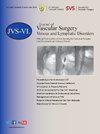Robotic-assisted left renal vein transposition with distal gonadal vein anastomosis: A novel technique for dual venous drainage in nutcracker syndrome
IF 2.8
2区 医学
Q2 PERIPHERAL VASCULAR DISEASE
Journal of vascular surgery. Venous and lymphatic disorders
Pub Date : 2025-07-17
DOI:10.1016/j.jvsv.2025.102289
引用次数: 0
Abstract
Objective
To evaluate the feasibility and outcomes of a novel robotic-assisted laparoscopic technique—Di's II robotic-assisted left renal vein (LRV) transposition with distal gonadal vein (GV) anastomosis—creating dual venous drainage for treating nutcracker syndrome (NCS).
Methods
Between December 2023 and October 2024, three male patients (median age, 14 years) with NCS underwent robotic-assisted LRV transposition using the Di's II technique. Key procedural innovations included selective occlusion of the infrarenal inferior vena cava (IVC) and LRV without right renal vein clamping, combined with distal GV anastomosis to enhance venous drainage. Operative parameters, including anastomosis time, blood loss, and postoperative outcomes, were analyzed retrospectively.
Results
All procedures were successfully completed robotically. Median total operative time was 145 minutes (range, 135-160 minutes), with LRV and GV anastomosis times of 25 minutes (range, 24-27 minutes). The median estimated blood loss was 40 mL (range, 30-50 mL). Postoperative imaging confirmed resolution of LRV compression, with pressure gradients reduced to ≤2.8 mm Hg. Symptoms (hematuria, proteinuria, and varicocele) resolved within 6 months, and no perioperative complications occurred during follow-up.
Conclusions
The Di's II technique represents a safe and effective minimally invasive approach for NCS, combining robotic precision with dual venous drainage to alleviate LRV hypertension and pelvic congestion. Preliminary outcomes demonstrate technical feasibility, a lower ischemia risk, and symptom resolution, supporting further validation in larger cohorts.
机器人辅助左肾静脉转位与性腺远端静脉吻合:胡桃夹子综合征双静脉引流的新技术。
目的:评价机器人辅助腹腔镜下左肾静脉(LRV)移位与性腺远端静脉吻合双静脉引流治疗胡桃钳综合征(NCS)的可行性和效果。方法:在2023年12月至2024年10月期间,3名NCS男性患者(中位年龄:14岁)使用Di's II技术进行了机器人辅助的LRV转位。关键的手术创新包括选择性阻断肾下腔静脉(IVC)和LRV,不夹持右肾静脉,结合性腺远端静脉吻合术加强静脉引流。回顾性分析手术参数,包括吻合时间、出血量和术后结果。结果:所有手术均成功完成。中位总手术时间145分钟(范围135 ~ 160),LRV与性腺静脉吻合时间25分钟(范围24 ~ 27)。中位失血量为40 mL(范围:30-50)。术后影像学证实LRV压缩分辨率,压力梯度降至≤2.8 mmHg。症状(血尿、蛋白尿、精索静脉曲张)在6个月内消失,随访期间无围手术期并发症发生。结论:Di’s II技术是一种安全有效的微创治疗NCS的方法,结合机器人精度和双静脉引流来缓解LRV高血压和盆腔充血。初步结果显示技术可行性,缺血风险降低,症状缓解,支持在更大的队列中进一步验证。
本文章由计算机程序翻译,如有差异,请以英文原文为准。
求助全文
约1分钟内获得全文
求助全文
来源期刊

Journal of vascular surgery. Venous and lymphatic disorders
SURGERYPERIPHERAL VASCULAR DISEASE&n-PERIPHERAL VASCULAR DISEASE
CiteScore
6.30
自引率
18.80%
发文量
328
审稿时长
71 days
期刊介绍:
Journal of Vascular Surgery: Venous and Lymphatic Disorders is one of a series of specialist journals launched by the Journal of Vascular Surgery. It aims to be the premier international Journal of medical, endovascular and surgical management of venous and lymphatic disorders. It publishes high quality clinical, research, case reports, techniques, and practice manuscripts related to all aspects of venous and lymphatic disorders, including malformations and wound care, with an emphasis on the practicing clinician. The journal seeks to provide novel and timely information to vascular surgeons, interventionalists, phlebologists, wound care specialists, and allied health professionals who treat patients presenting with vascular and lymphatic disorders. As the official publication of The Society for Vascular Surgery and the American Venous Forum, the Journal will publish, after peer review, selected papers presented at the annual meeting of these organizations and affiliated vascular societies, as well as original articles from members and non-members.
 求助内容:
求助内容: 应助结果提醒方式:
应助结果提醒方式:


